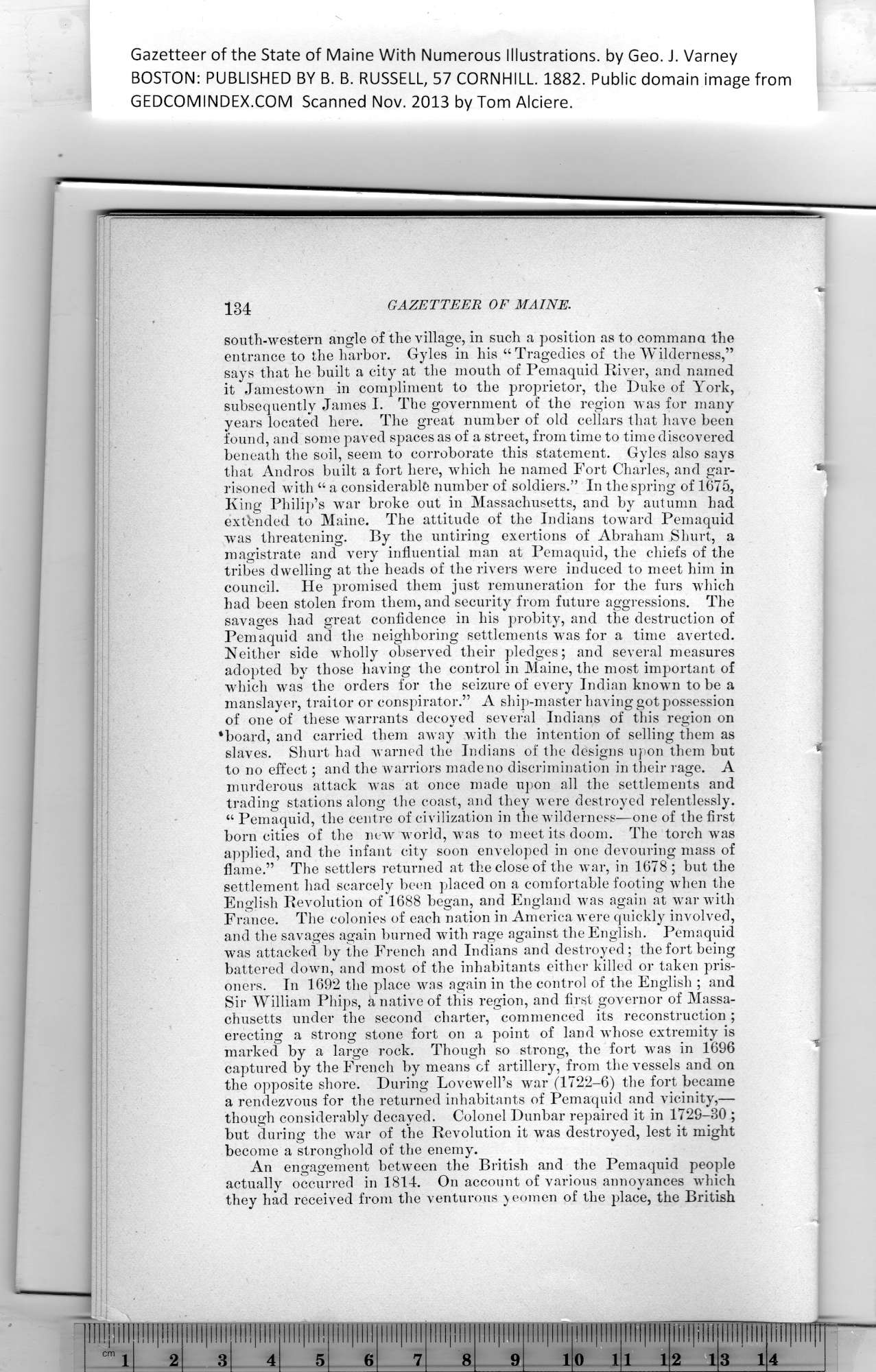|
Gazetteer of the State of Maine With Numerous Illustrations, by Geo. J. Varney
BOSTON: PUBLISHED BY B. B. RUSSELL, 57 CORNHILL. 1882. Public domain image from
134 GAZETTEER OF MAINE.
south-western angle of the village, in such a position as to command the
entrance to the harbor. Gyles in his “Tragedies of the Wilderness,”
says that he built a city at the mouth of Pemaquid River, and named
it Jamestown in compliment to the proprietor, the Duke of York,
subsequently James I. The government of the region was for many
years located here. The great number of old cellars that have been
found, and some paved spaces as of a street, from time to time discovered
beneath the soil, seem to corroborate this statement. Gyles also says
that Andros built a fort here, which he named Fort Charles, and gar-
risoned with “ a considerable number of soldiers.” In the spring of 1675,
King Philip’s war broke out in Massachusetts, and by autumn had
extended to Maine. The attitude of the Indians toward Pemaquid
was threatening. By the untiring exertions of Abraham Shurt, a
magistrate and very influential man at Pemaquid, the chiefs of the
tribes dwelling at the heads of the rivers were induced to meet him in
council. He promised them just remuneration for the furs which
had been stolen from them, and security from future aggressions. The
savages had great confidence in his probity, and the destruction of
Pemaquid and the neighboring settlements was for a time averted.
Neither side wholly observed their pledges; and several measures
adopted by those having the control in Maine, the most important of
which was the orders for the seizure of every Indian known to be a
manslayer, traitor or conspirator.” A ship-master having got possession
of one of these warrants decoyed several Indians of this region on
‘hoard, and carried them away with the intention of selling them as
slaves. Shurt had warned the Indians of the designs upon them but
to no effect; and the warriors made no discrimination in their rage. A
murderous attack was at once made upon all the settlements and
trading stations along the coast, and they were destroyed relentlessly.
“ Pemaquid, the centre of civilization in the wilderness—one of the first
born cities of the new world, was to meet its doom. The torch was
applied, and the infant city soon enveloped in one devouring mass of
flame.” The settlers returned at the close of the war, in 1678; but the
settlement had scarcely been placed on a comfortable footing when the
English Revolution of 1688 hegan, and England was again at war with
France. The colonies of each nation in America were quickly involved,
and the savages again burned with rage against the English. Pemaquid
was attacked by the French and Indians and destroyed; the fort being
battered down, and most of the inhabitants either killed or taken pris-
oners. In 1692 the place was again in the control of the English ; and
Sir William Phips, a native of this region, and first governor of Massa-
chusetts under the second charter, commenced its reconstruction;
erecting a strong stone fort on a point of land whose extremity is
marked by a large rock. Though so strong, the fort was in 1696
captured by the French by means of artillery, from the vessels and on
the opposite shore. During Lovewell’s war (1722-6) the fort became
a rendezvous for the returned inhabitants of Pemaquid and vicinity,—
though considerably decayed. Colonel Dunbar repaired it in 1729-30 ;
but during the war of the Revolution it was destroyed, lest it might
become a stronghold of the enemy.
An engagement between the British and the Pemaquid people
actually occurred in 1814. On account of various annoyances which
they had received from the venturous jeomen of the place, the British
PREVIOUS PAGE ... NEXT PAGE
This page was written in HTML using a program written in Python 3.2
|
